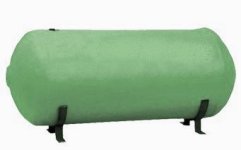sdboers
Bronze Member
Hey Folks,
Let me see if I can tidy up downstairs enough to snap a few pictures, although I'm happy to describe it here first...
The holding tanks are cylindrical tanks - rounded on each end - and stand upright. Like this picture - but standing on end.

As mentioned - the clean water is drawn off the top, and the treated, but not yet settled water comes in the bottom. The sediment settles to the bottom rounded portion of the tank. There are actually two pipes that come out the bottom of that tank. One is the intake for new water, and one is the blowoff for the waste. Having not seen inside the tank - I "presume" that the intake goes higher up in the tank than the blowoff does - the blowoff would be the lowest point in the tank at the rounded bottom. When the blowoff valve is opened, the pressure from incoming water would push any accumulated sediment out the bottom and into the discharge.
Am I making any sense?
*EDIT* Adding content:
I missed an explanation of the "automatic" part... The valves that open to flush the tanks are manual, and can be used as such. Instead of manually flushing them however, I leave them open all of the time and put an automatic valve further downstream on the discharge line. This valve is closed when there is no power and open when there is power. Power is supplied via a standard 110 volt lamp timer. Scheduled 3 times weekly from midnight for 1 minute.
Sean.
Let me see if I can tidy up downstairs enough to snap a few pictures, although I'm happy to describe it here first...
The holding tanks are cylindrical tanks - rounded on each end - and stand upright. Like this picture - but standing on end.

As mentioned - the clean water is drawn off the top, and the treated, but not yet settled water comes in the bottom. The sediment settles to the bottom rounded portion of the tank. There are actually two pipes that come out the bottom of that tank. One is the intake for new water, and one is the blowoff for the waste. Having not seen inside the tank - I "presume" that the intake goes higher up in the tank than the blowoff does - the blowoff would be the lowest point in the tank at the rounded bottom. When the blowoff valve is opened, the pressure from incoming water would push any accumulated sediment out the bottom and into the discharge.
Am I making any sense?
*EDIT* Adding content:
I missed an explanation of the "automatic" part... The valves that open to flush the tanks are manual, and can be used as such. Instead of manually flushing them however, I leave them open all of the time and put an automatic valve further downstream on the discharge line. This valve is closed when there is no power and open when there is power. Power is supplied via a standard 110 volt lamp timer. Scheduled 3 times weekly from midnight for 1 minute.
Sean.
Last edited:
